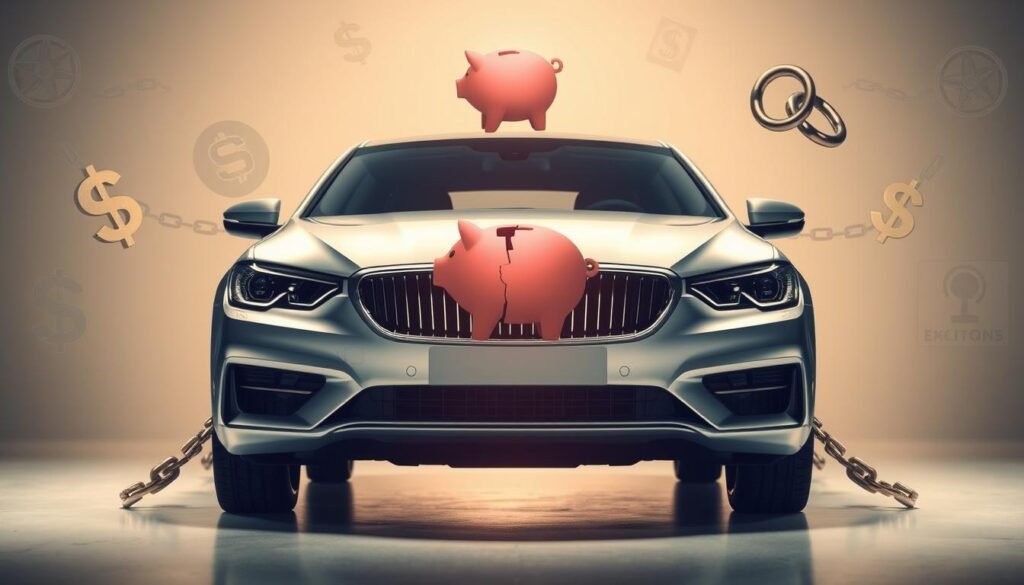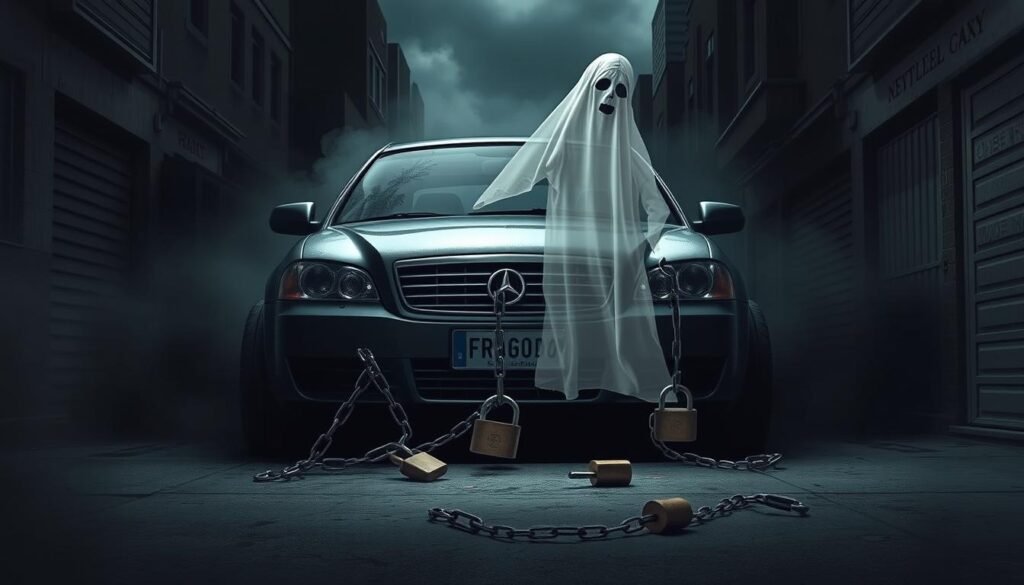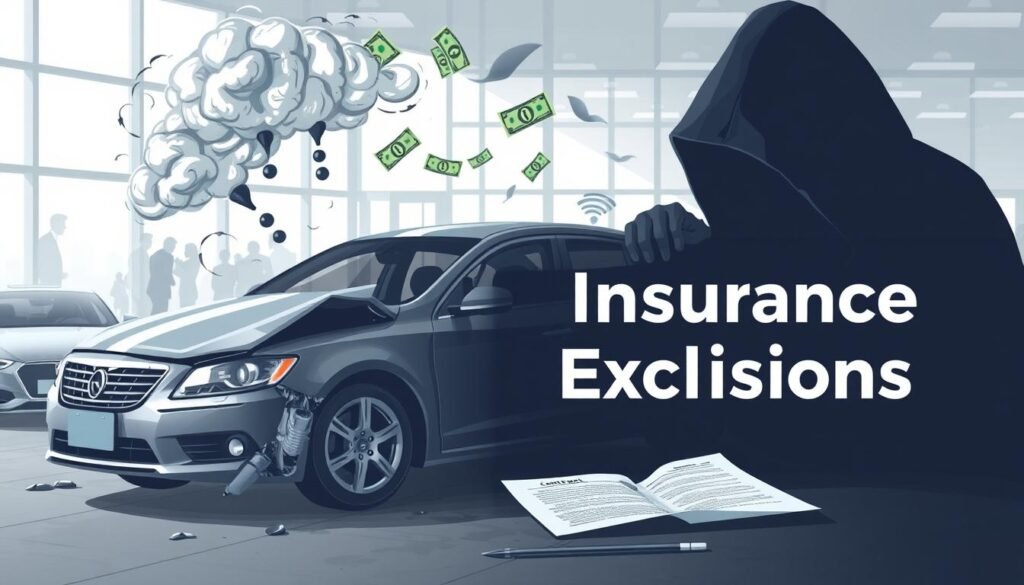Gap insurance protects you financially if your car is totaled. However, it doesn’t always apply. Knowing when gap insurance won’t pay is crucial for vehicle owners.
This guide explores scenarios where gap insurance may not cover you. We’ll look at situations like missed payments, repossession, and non-total loss accidents. Understanding these limits helps you make informed decisions about your policy.
Table of Contents
ToggleKey Takeaways
- Gap insurance has specific exclusions and limitations that policyholders must be aware of.
- Non-total loss accidents, intentional damage, and negative equity from previous loans are common reasons for denied gap insurance claims.
- Certain vehicles, aftermarket modifications, and missed loan payments can also void gap insurance coverage.
- Knowing the gap insurance restrictions and exceptions is crucial to ensure you are fully protected in the event of a total loss.
- Understanding the gap insurance claim process and requirements is important to maximize your chances of a successful payout.
Introduction to Gap Insurance
What is Gap Insurance and Why Is It Important?
Gap insurance covers the difference between your car’s value and loan balance if it’s totaled. This coverage is vital for high-interest loans or leases. It bridges the gap between depreciated value and outstanding loan balance.
Cars typically lose 20% of their value in the first year. This can create a big financial burden if your car is totaled. Gap insurance protects against this loss, saving you from owing a large sum.
Benefits of Gap Insurance Coverage
- Financial protection against the “gap” between the vehicle’s actual cash value and the outstanding loan balance
- Peace of mind, especially for those with high-interest car loans or lease agreements
- Coverage for the full replacement cost of the vehicle, rather than just the depreciated value
- Potential savings on monthly insurance premiums compared to traditional comprehensive and collision coverage
Gap insurance is crucial for car owners with significant loan balances or high-interest financing. It protects against vehicle depreciation’s financial impact. This coverage ensures a smoother transition if your car is totaled.
| Metric | Value |
|---|---|
| Average Vehicle Depreciation in First Year | 20% |
| Average Gap Insurance Cost (per month) | $3 |
| Average Gap Insurance Cost (per year) | $36 |
| Typical Dealership Gap Insurance Cost | $400 – $600 |
| Typical Lender Gap Insurance Cost | $500 – $700 |
Missed or Late Loan Payments
Gap insurance doesn’t cover unpaid or late loan repayments. It won’t reimburse fines, costs, or fees due to missed payments. This includes penalties for delayed or missed vehicle loan repayments.
Gap insurance covers the difference between your car’s value and loan balance if totaled. It doesn’t cover issues with your payment history or loan agreement performance. Missed or late payments are your responsibility.
Stay current on loan repayments to keep gap insurance coverage. Late payments can void your policy or lead to claim denial. You’d then be responsible for the remaining loan balance.
| Scenario | Gap Insurance Coverage |
|---|---|
| Loan Balance: $30,000 | Covered |
| Vehicle Value: $25,000 | Covered |
| Missed Loan Payments | Not Covered |
| Late Loan Payments | Not Covered |
To keep gap insurance protection, maintain consistent loan payments. Avoid missed or late repayments. Otherwise, your policy may not work when you need it most.
“Gap insurance is designed to cover the difference between what you owe on your car loan and the actual cash value of your vehicle. It does not, however, cover missed or late loan payments.”
Non-Total Loss Accidents
Gap insurance covers total loss scenarios when a vehicle is declared a complete loss. It doesn’t apply to damaged vehicles not considered a total loss. This happens when repair costs are less than the vehicle’s market value.
Understanding the Total Loss Criterion
For gap insurance to apply, the primary insurer must deem the vehicle a total loss. This usually occurs when repair costs exceed 70-80% of the car’s actual cash value. If damage falls below this threshold, gap insurance won’t provide coverage.
When gap insurance doesn’t cover non-total loss accidents, the owner pays the difference. This covers the gap between the loan balance and the primary insurer’s payout. It can result in significant out-of-pocket expenses for the policyholder.
Understanding gap insurance total loss criteria and situations where gap insurance doesn’t apply for accidents is crucial. It helps avoid unexpected costs and ensures proper coverage for your vehicle.
“Gap insurance is designed to cover only total loss scenarios. If the vehicle is damaged but not considered a total loss by the primary insurer, gap insurance will not apply.”
| Insurer | Average Annual Cost of Gap Insurance |
|---|---|
| Travelers | $34 |
| Progressive | $38 |
| Auto-Owners Insurance | $48 |
| American Family | $51 |
| State Auto | $52 |
| Erie | $58 |
| Westfield | $70 |
| Shelter | $141 |
Gap Insurance Exclusions: Add-Ons and Extras
Gap insurance protects against the financial gap between your car’s value and outstanding loan balance. However, it doesn’t cover all additional costs from your vehicle purchase. Understanding these limitations is crucial for making informed decisions.
A key exclusion is coverage for add-ons and extras financed with your car loan. This includes extended warranties, service contracts, paint protection, and aftermarket parts. Even the gap insurance premium itself isn’t covered.
In case of a total loss, gap insurance won’t reimburse these extra expenses. Knowing what’s covered helps align your expectations with the policy’s protection.
| Gap Insurance Coverage | Exclusions |
|---|---|
| – Covers the difference between your car’s value and outstanding loan balance | – Does not cover add-ons and extras financed with the car loan |
| – Typically up to $50,000 in coverage | – Excludes extended warranties, service contracts, paint protection, aftermarket parts, and the gap insurance premium itself |
| – Includes up to $1,000 for the insurance deductible | – Does not reimburse for these additional costs in the event of a total loss |
Grasping gap insurance exclusions helps you choose coverage that fits your needs and financial situation. This knowledge ensures you’re prepared for various scenarios.

when does gap insurance not pay
Gap insurance has limits in covering rapid vehicle depreciation. New cars can lose up to 20% of their value in the first year. This quick drop often exceeds the coverage gap insurance provides.
The policy may not fully compensate for the significant value loss. Drivers might still owe money on their loan after an insurance payout. This leaves them responsible for the remaining balance.
The gap insurance limitations due to depreciation are clear when value loss outpaces coverage. In these cases, policyholders may find themselves underinsured. They could owe more on the loan than their insurance covers.
Car owners should know that gap insurance not covering rapid vehicle depreciation is common. It’s crucial to review policy terms carefully. Make sure the coverage aligns with your needs and expected vehicle depreciation.
| Depreciation Rate | Gap Insurance Coverage Limitations |
|---|---|
| 20% in the first year | Gap insurance may not fully cover the difference between the loan balance and the car’s insured value |
| Faster than the gap insurance policy coverage | Policyholder may be responsible for the remaining loan balance not covered by the insurance payout |
| Varies by vehicle type and model | Drivers should research the expected depreciation rates for their specific vehicle before purchasing gap insurance |
When does gap insurance not pay? Often, it’s due to rapid vehicle depreciation. This can exceed the policy’s coverage. Drivers should consider these limitations carefully. Weigh the benefits against your vehicle’s expected depreciation before deciding on coverage.
Situations Where Gap Insurance Won’t Pay Due to Repossession
Gap insurance doesn’t cover repossessed vehicles. It only pays the difference between your loan balance and the car’s depreciated value. This applies when your car is totaled or stolen.
If your lender repossesses your car due to missed payments, gap insurance won’t help. The lender now owns the vehicle, so there’s no “gap” to cover. Gap insurance doesn’t protect against loan default consequences.
Gap insurance can’t shield you from repossession’s effects on your credit score. It also won’t cover extra fees or potential deficiency judgments. In these cases, gap insurance is useless.
To avoid issues, always pay your loan on time and in full. If you’re struggling, talk to your lender about payment options. This can help prevent repossession.
| Situation | Gap Insurance Coverage |
|---|---|
| Car Totaled or Stolen | Covers the difference between loan balance and car’s depreciated value |
| Car Repossessed | Provides no coverage |
Gap insurance protects your finances if your car is totaled or stolen. However, it won’t help if your car is repossessed. Knowing these limits helps you make smart choices and avoid surprises.
Negative Equity from Previous Loans
Negative equity occurs when your loan balance exceeds your car’s value. This happens often due to rapid vehicle depreciation. Many car owners find themselves owing more than their car is worth.
Gap insurance doesn’t usually cover negative equity from previous loans. It only covers the specific vehicle under the current loan. This excludes debts carried over from prior vehicle financing agreements.
If you have negative equity, consider other options. You might buy additional coverage or negotiate with your lender. This can help protect you from financial burdens if your car is totaled.
Understanding the Impact of Negative Equity
Negative equity can limit gap insurance’s effectiveness. It may leave you responsible for a large part of the outstanding balance. This could result in a significant financial burden.
- Vehicles on finance often end up in negative equity due to rapid depreciation.
- Negative equity occurs when the car’s market value is less than the outstanding loan amount.
- Gap insurance typically does not cover negative equity rolled over from a previous loan.
- Providers may have limits on the amount of extra negative equity they will cover.
- Carefully consider gap insurance if you have negative equity from a prior vehicle financing agreement.
Understanding gap insurance’s limits helps car owners make smart decisions. They can explore other options to protect themselves from financial losses. This knowledge is crucial when dealing with negative equity situations.
Intentional Damage, Fraud, or Illegal Activities
Gap insurance won’t pay out for intentional damage, fraud, or illegal activities. It only covers accidental total loss events. Deliberate, fraudulent, or criminal behavior is not included.
Insurance providers don’t cover intentional criminal acts. This goes against public policy considerations. Insurance contracts should benefit policyholders for events beyond their control.
If you damage your vehicle on purpose or stage an accident, your claim will likely be denied. This exclusion also applies to losses caused by illegal activities, like theft during a crime.
Gap insurance protects you from unexpected, unintentional total loss events. It’s not a safety net for deliberate or unlawful behavior. Understanding these limitations is crucial for policyholders.
Maintain transparency and responsible behavior to ensure your gap insurance supports you when needed. This way, you can rely on your coverage in genuine emergencies.

“Insurance is a contract of indemnity, not a license to engage in unlawful conduct.”
Gap Insurance Coverage Limitations
Gap insurance offers protection for total loss situations. However, it’s crucial to know its limitations and exclusions. These can affect your coverage and potential payouts.
Coverage Period Limitations
Most gap insurance policies have a limited coverage period. This usually lasts 3 to 5 years from the vehicle purchase date. After this time, the policy no longer provides coverage.
This applies even if you still owe more than your vehicle’s value. It’s important to keep track of your policy’s expiration date.
Financing Restrictions
Gap insurance may have restrictions on the types of financing it covers. Some policies only apply to traditional auto loans. They might exclude leased vehicles or alternative financing options.
There may also be limits on loan amounts or interest rates. These factors can affect your eligibility for gap insurance coverage.
Maximum Payout Limits
Gap insurance policies often have a cap on the maximum payout amount. This limit applies even if your loan balance exceeds the vehicle’s value. You might still owe money if the payout doesn’t cover the entire gap.
Review your policy’s terms and conditions carefully. Understanding these limitations helps you make an informed decision about gap insurance. Consider if it fits your vehicle financing needs.
| Limitation | Description |
|---|---|
| Coverage Period | Most gap insurance policies have a limited coverage period, typically 3-5 years from the vehicle purchase date. |
| Financing Restrictions | Gap insurance may only cover traditional auto loans and exclude leased vehicles or alternative financing options. |
| Maximum Payout Limits | Gap insurance policies often have a cap on the maximum amount they will pay, even if the outstanding loan balance exceeds the vehicle’s value. |
Claiming Gap Insurance: Process and Requirements
Filing a gap insurance claim can provide financial relief after a total loss on your vehicle. The claim process involves key steps for a smooth outcome. Understanding the requirements is crucial for effective navigation.
To start a gap insurance claim, contact your provider after the primary auto insurance settlement. They’ll guide you through the necessary documentation and information. The company will send a check for the difference between the car’s value and loan balance.
In Texas, gap insurance cost shouldn’t exceed five percent of the loan amount. The claim process typically takes four to six weeks. Policyholders should promptly provide any additional requested documentation to speed things up.
For a successful gap insurance claim, have these documents ready:
- Insurance settlement statements
- Loan or lease contract
- Police reports (if applicable)
- Loan history
Continue making loan or lease payments while waiting for claim processing. This helps avoid negative credit reporting. Remember, dealers or primary insurers may not file the claim automatically. You might need to start the process yourself.
Understanding the gap insurance claim process and requirements helps you navigate confidently. This ensures you receive the financial protection you need during a challenging time.
| Statistic | Value |
|---|---|
| Cost of gap insurance in Texas | Should not exceed 5% of the loan amount |
| Average processing time for a GAP insurance claim | 4-6 weeks |
| Typical coverage of GAP insurance | Difference between the current market value of a car and the amount still owed on it |
Conclusion
Gap insurance is a useful safety net, but it has limitations. It won’t cover missed payments, non-total loss accidents, or certain add-ons. Understanding these restrictions is crucial for vehicle owners.
Knowing when Gap insurance applies helps you make smart choices. It ensures proper protection in case of a total loss. This knowledge lets you navigate the complexities of coverage effectively.
Being aware of Gap insurance’s exclusions is vital. It helps you maximize this protection and avoid financial pitfalls. Stay informed to make the best decisions for your needs.
FAQ
When does gap insurance not pay out?
Gap insurance may not cover certain situations. These include missed loan payments and non-total loss accidents. It also excludes additional items like extended warranties.
Coverage might not apply if vehicle depreciation exceeds the policy limit. Repossession due to non-payment isn’t covered either. Negative equity from previous loans and intentional damage are also excluded.
What are the common limitations of gap insurance coverage?
Gap insurance policies often have specific limitations. These include coverage period restrictions, usually lasting 3-5 years. Financing restrictions may apply to loan amounts and interest rates.
Policies also have maximum payout limits. This means they won’t cover amounts exceeding the specified limit.
How do I file a gap insurance claim?
To file a gap insurance claim, act quickly. Contact your provider once your car is declared a total loss. Your primary auto insurance should have determined the settlement.
Provide all necessary documentation to your gap insurance company. They’ll review your claim and process it accordingly. If approved, you’ll receive a check for the difference between values.

